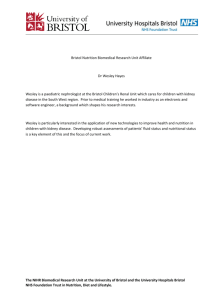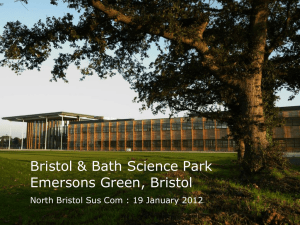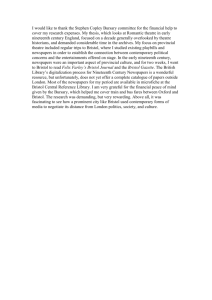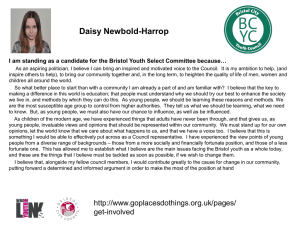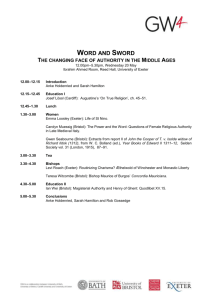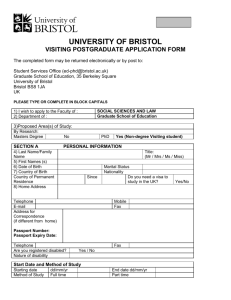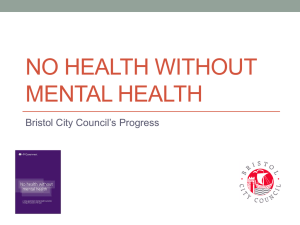The Bristol Story: a graphic and (mostly) true history of the greatest
advertisement
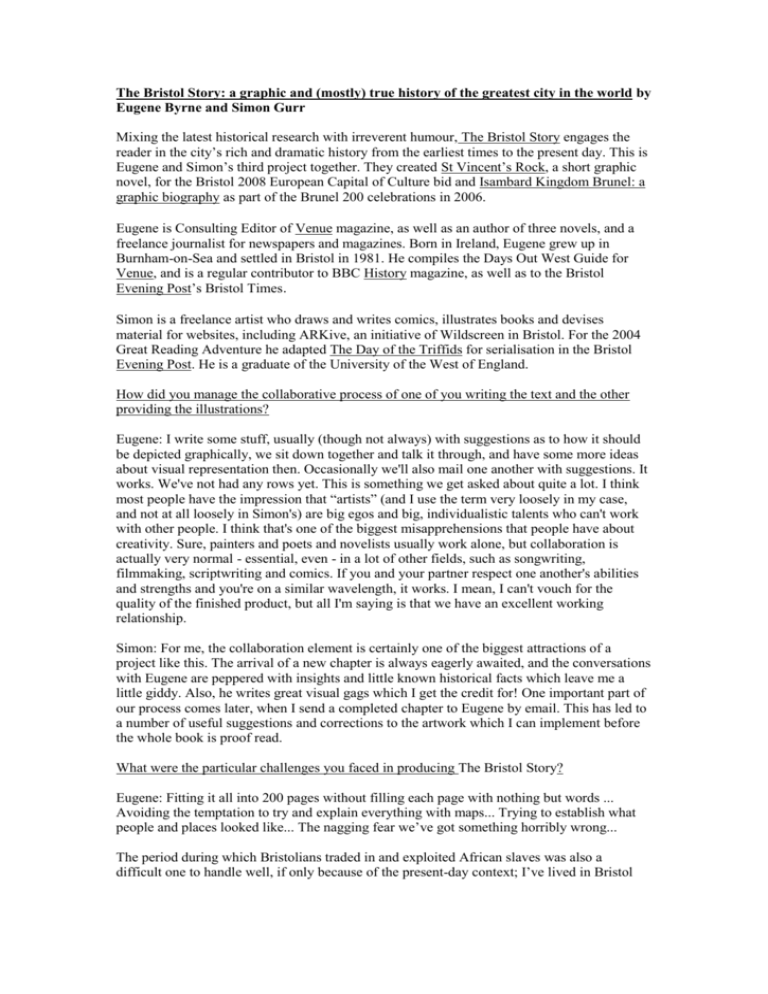
The Bristol Story: a graphic and (mostly) true history of the greatest city in the world by Eugene Byrne and Simon Gurr Mixing the latest historical research with irreverent humour, The Bristol Story engages the reader in the city’s rich and dramatic history from the earliest times to the present day. This is Eugene and Simon’s third project together. They created St Vincent’s Rock, a short graphic novel, for the Bristol 2008 European Capital of Culture bid and Isambard Kingdom Brunel: a graphic biography as part of the Brunel 200 celebrations in 2006. Eugene is Consulting Editor of Venue magazine, as well as an author of three novels, and a freelance journalist for newspapers and magazines. Born in Ireland, Eugene grew up in Burnham-on-Sea and settled in Bristol in 1981. He compiles the Days Out West Guide for Venue, and is a regular contributor to BBC History magazine, as well as to the Bristol Evening Post’s Bristol Times. Simon is a freelance artist who draws and writes comics, illustrates books and devises material for websites, including ARKive, an initiative of Wildscreen in Bristol. For the 2004 Great Reading Adventure he adapted The Day of the Triffids for serialisation in the Bristol Evening Post. He is a graduate of the University of the West of England. How did you manage the collaborative process of one of you writing the text and the other providing the illustrations? Eugene: I write some stuff, usually (though not always) with suggestions as to how it should be depicted graphically, we sit down together and talk it through, and have some more ideas about visual representation then. Occasionally we'll also mail one another with suggestions. It works. We've not had any rows yet. This is something we get asked about quite a lot. I think most people have the impression that “artists” (and I use the term very loosely in my case, and not at all loosely in Simon's) are big egos and big, individualistic talents who can't work with other people. I think that's one of the biggest misapprehensions that people have about creativity. Sure, painters and poets and novelists usually work alone, but collaboration is actually very normal - essential, even - in a lot of other fields, such as songwriting, filmmaking, scriptwriting and comics. If you and your partner respect one another's abilities and strengths and you're on a similar wavelength, it works. I mean, I can't vouch for the quality of the finished product, but all I'm saying is that we have an excellent working relationship. Simon: For me, the collaboration element is certainly one of the biggest attractions of a project like this. The arrival of a new chapter is always eagerly awaited, and the conversations with Eugene are peppered with insights and little known historical facts which leave me a little giddy. Also, he writes great visual gags which I get the credit for! One important part of our process comes later, when I send a completed chapter to Eugene by email. This has led to a number of useful suggestions and corrections to the artwork which I can implement before the whole book is proof read. What were the particular challenges you faced in producing The Bristol Story? Eugene: Fitting it all into 200 pages without filling each page with nothing but words ... Avoiding the temptation to try and explain everything with maps... Trying to establish what people and places looked like... The nagging fear we’ve got something horribly wrong... The period during which Bristolians traded in and exploited African slaves was also a difficult one to handle well, if only because of the present-day context; I’ve lived in Bristol since 1981 and knowing what I do of the city’s history I would say that it’s more contentious right now than anytime since the 1830s. The worst thing though, the very worst, has been the bloody Reformation. It dawned on me with increasing horror that the religious knowledge that most people my age take for granted no longer exists among the majority of people under 30 because only a minority are regular church-goers and most have acquired no knowledge of Christian theology beyond a few RE lessons. So you then have to explain what monks and nuns and priests and friars and bishops are, and how people were prepared to burn other people at the stake over the question of whether or not a Catholic priest has the power to turn bread and wine into the body and blood of Christ. Once we’d done that bit, the rest was easy by comparison. Simon: The amount and depth of research has been challenging – with the Brunel biography it was a relatively short time period covered but The Bristol Story has meant much deeper research in order to maintain historical accuracy with costume and artefacts. What have been the most useful sources of information to you? Eugene: Once you start looking, it’s actually quite humbling to find there are actually loads of local history books, some of them very good. A lot of people have been very helpful, ranging from several academics through to many people in the museums service as well as several amateur enthusiasts. Again, you find out that actually there are an awful lot of people out there who care passionately about local history, and many of them have been incredibly generous with their time and expertise. The web is useful for the quick look-up. There is quite a lot of Bristol material out there, but you don’t always want to trust it. There are lots of useful places, apart from the obvious museums and such. I think it’s essential to bring information and places together and I’ve actually taken my children on traipses around the city centre and told them all manner of wonderful stories about St Mary Redcliffe, or Temple Church, or the Blitz which they will thank me for in years to come… Perhaps. Simon: About half of the picture research has been done using images sourced from the Internet and the rest from books – from my own and Eugene’s collections, from friends who are specialists in particular areas (for example, fashion history) and from local libraries. On a couple of occasions it has been necessary to go ‘on location’ to photograph local sites, for example, effigies in local churches. Bristol City museum continues to be useful, particularly the map mezzanine and the Braikenridge collection. What have been your particular favourites of the Bristol events and people that you have included in the book? Eugene: Too many to list, but here’s a few ... Until we started work on this, I’d not realised quite how amazing the city’s medieval history is. All that stuff about the Knights Templar and the various occasions the Castle features in the big dynastic wars of the time. At the time of the Reformation I love the story of Sir William Sharington, a horrible sleazy crook who did very well out of the Dissolution of the Monasteries and was running a mint at Bristol castle, turning gold and silver plate and ornaments seized from the monasteries and churches into coin. I adore the part the Quakers and Methodists play in Bristol’s story. Everyone says it’s about the religion, which it is, but what they also did was give working people structure, discipline and self-respect in their lives. And of course they also played a major part in the campaign to abolish slavery. My other favourite episode is World War Two, if favourite is the right word for a period of such horror. The fact is, Bristol’s public memory of that six years is astonishingly opaque. Some 1300 people died, thousands more were scarred physically and psychologically, often for life. And yet Bristol has always behaved as though none of this happened. The memorial to the Blitz is a little plaque on a bombed out church in Castle Park. That’s it. It’s a fascinating period which explains how so much of Bristol got to be the way it is today. What we’ve also done is included a lot of local myths – you know, the obvious stuff about the blanket being invented by a Bristolian, or America being named after a Bristolian and some less well-known myths as well, like the hundreds of Black Death victims buried somewhere under Broadmead. Simon: Bristol’s endurance of Edward II’s three-year long siege was a pretty amazing episode. I have enjoyed drawing the villains, and there are so many villains in Bristol’s history! An extended version of this interview with Simon and Eugene is on the website at www.bristolreads.com
